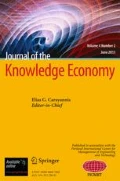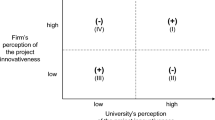Abstract
Past managerial literature found that prior experience of organisations is an important factor affecting somehow their willingness in participating to a R&D consortium. Our research extends this body of knowledge in two directions: (1) by investigating how prior experience affects the choices of organisations coordinating project proposals for R&D programs (the so-called “coordinators”) in terms of composition of their R&D consortia, and (2) by analysing how prior experience affects co-opetition between project coordinators. The assumption of the study is that organisations coordinating and forming R&D consortia for R&D programs usually engage in co-opetitive relationships with each other. Therefore, the research question of the paper is, “how does prior experience affect the coordinators’ choices about the formation of their inter-organisational consortia within a R&D program?” We analysed 2.895 R&D projects of inter-organisational consortia which received funds by the European Union under more Framework Programmes in order to implement R&D projects for the aerospace industry.

Similar content being viewed by others
Notes
Absorptive capacity is the “firm’s ability to value, assimilate and apply new knowledge towards commercial ends”. The other key condition is the intensity of effort (Cohen and Levinthal 1990).
Open innovation is “the use of purposive inflows and outflows of knowledge to accelerate internal innovation, and expand the markets for external use of innovation, respectively”(Chesbrough et al. p. 1 2006).
By experienced coordinators we considered organizations belonging to the first decile of the ranking based on the number of projects coordinated at time t-1.
References
Arranz, N., & Fernandez de Arroyabe, J. C. (2007). Governance structures in R&D networks: An analysis in the European context. Technological Forecasting & Social Change, 74(5), 645–662.
Autant-Bernard, C., Billand, P., Frachisse, D., & Massard, N. (2007). Social distance versus spatial distance in R&D cooperation: Empirical evidence from European collaboration choices in micro and nanotechnologies”. Papers in Regional Science, 86, 495–519.
Barajas, A., & Huergo, E. (2010). International R&D cooperation within the EU Framework Programme: empirical evidence for Spanish firms”. Economics of Innovation and New Technology, 19(1), 87–111.
Brandenburger, A. M., & Nalebuff, B. J. (1996). Co-opetition. New York: Doubleday.
Breschi, S., & Cusmano, L. (2004). Unveiling the texture of a European research area: Emergence of oligarchic networks under EU Framework Programmes. International Journal of Technology Management. Special Issue on Technology Alliances, 27(8), 747–772.
Busom, I., & Fernández-Ribas, A. (2008). The impact of firm participation in R&D programmes on R&D partnerships. Research Policy, 37, 240–257.
Caloghirou, Y., Vonortas, N. S., & Ioannides, S. (Eds.). (2004). European Collaboration in Research and Development. UK: Edward Elgar, Cheltenham.
Cassiman, B., Di Guardo, M. C., & Valentini, G. (2009). Organising R&D projects to profit from innovation: Insights from co-opetition. Long Range Planning, 42(2), 216–233.
Chesbrough, H. W., Vanhaverbeke, W., & West, J. (2006). Open Innovation. Researching a New Paradigm. New York: Oxford University Press.
Cohen, W. M., & Levinthal, D. A. (1990). Absorptive capacity: a new perspective on learning and innovation. Administrative Science Quarterly, 35, 128–152.
Doz, Y. L., Olk, P. M., & Ring, P. S. (2000). Formation processes of R&D consortia: Which path to take: Where does it lead? Strategic Management Journal, 21(3), 239–266.
Gnyawali, D. R., & Madhavan, R. (2001). Cooperative networks and competitive dynamics: A structural embeddedness perspective. Academy of Management Review, 26(3), 431–445.
Gnyawali, D. R., & Park R. (2011). Co-opetition between Giants: Collaboration between competitors for technological innovation. Forthcoming in Research Policy.
Hagedoorn, J. (1993). Understanding the rationale of strategic technology partnering: interorganizational modes of cooperation and sectoral differences. Strategic Management Journal, 14(5), 371–385.
Hagedoorn, J., Roijakkers, N., & Van Kranenburg, H. (2006). Inter-firm R&D networks: the importance of strategic network capabilities for high-tech partnership formation. British Journal of Management, 17, 39–53.
Hamel, G. (1991). Competition for competence and inter-partner learning within international strategic alliances. Strategic Management Journal, 12, 83–103.
Hernán, R., Marín, P. L., & Siotis, G. (2003). An empirical evaluation of the determinants of research joint venture formation. The Journal of Industrial Economics, LI(1), 75–89.
Madhok, A. (2000). Transaction (In)efficiency, value (In)Efficiency and inter-firm collaboration. In D. Faulkner & M. de Rond (Eds.), Cooperative strategy: Economic, business, and organizational issues. UK: Oxford University Press.
Miotti, L., & Sachwald, F. (2003). Cooperative R&D: Why and with whom? An integrated framework of analysis. Research Policy, 32, 1481–1499.
Nonaka, I., & Nishiguchi, T. (Eds.). (2001). Knowledge emergence: social, technical, and evolutionary dimensions of knowledge creation. New York: Oxford University Press.
Padula, G., & Dagnino, G. B. (2008). Untangling the rise of co-opetition: the intrusion of competition in a cooperative game structure. International Studies of Management and Organization, 37(2), 32–52.
Paier, M., & Scherngell, T. (2008). “Determinants of collaboration in European R&D networks: Empirical evidence from a discrete choice model”, 12th International Conference of the International Schumpeter Society, July, 2nd - 5th. Rio de Janeiro: CD-ROM.
Sakakibara, M. (1998). Heterogeneity of firm capabilities and cooperative research and development: an empirical examination of motives. Strategic Management Journal, 18(1), 143–164.
Sakakibara, M. (2002). Formation of R&D consortia: Industry and company effects. Strategic Management Journal, 23(11), 1033–1050.
Sampson, R. C. (2005). Experience effects and collaborative returns in R&D alliances. Strategic Management Journal, 26, 1009–1031.
Schiavone, F., & Simoni, M. (2011). An experience-based view of Co-opetition in R&D networks. European Journal of Innovation Management, 14(n. 2).
Schmiele, A., & Sofka, W. (2007). Internationalizing R&D Co-opetition: Dress for the dance with the devil. ZEW Discussion Paper. 07-045.
Teece, D. J., Pisano, G., & Shuen, A. (1997). Dynamic capabilities and strategic management. Strategic Management Journal, 18, 509–533.
Conflict of Interest
No conflict of interest.
Author information
Authors and Affiliations
Corresponding author
Additional information
Although the paper reports the common ideas of both the authors, Francesco Schiavone wrote sections: 1, 2, 3. Michele Simoni wrote sections 4, 5, 6.
Rights and permissions
About this article
Cite this article
Schiavone, F., Simoni, M. Prior Experience and Co-opetition in R&D Programs. J Knowl Econ 7, 819–835 (2016). https://doi.org/10.1007/s13132-015-0251-x
Received:
Accepted:
Published:
Issue Date:
DOI: https://doi.org/10.1007/s13132-015-0251-x




